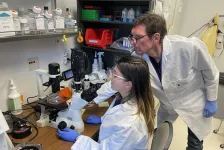(Press-News.org) Think about how frustrating it is to try to fit a gift into a box that is too small. Sometimes you just need a bigger box.
Building a bigger box
Nanocages are tiny artificial containers that can be used to deliver therapeutics to a target destination in the body. But some drug molecules are like gifts that are too big for a standard-sized nanocage ‘box’. Now, in an article published today in Nature Synthesis, researchers from the University of Cambridge describe how they have built a super-sized nanocage that could be used to deliver larger drug cargoes. They have built a bigger box.
Simple building blocks
Rational control over the self-assembly of these types of cages generally poses considerable challenges. So instead of following traditional self-assembly methods, the team decided to use a simple building block process inspired by natural biological systems. Using the new method, they were able to build progressively larger artificial nanocages, with the largest cage having an enclosed volume greater than 92 cubic nanometres -- the largest ligand-enclosed inner cavity volume ever made.
Larger cages have been reported, but they have more open ligand frameworks, which are not as useful because these cages have not been able to bind cargoes. Prospective ‘guest’ molecules slip out between the widely-spaced bars, unless they are covalently tethered to the ‘host’ framework.
First author Dr Kai Wu, a postdoctoral researcher in the Nitschke lab in the Yusuf Hamied Department of Chemistry, said: “The findings of this study are important because they demonstrate how we are able to create ever-larger complex, functional structures using simple building blocks.”
Larger cargoes
The super-sized nanocages have potential applications in fields such as drug delivery and biotechnology, where they could be used to deliver larger therapeutic biomolecules to specific parts of the body.
The researchers also note that the large internal cavities of the nanocages could serve as a platform for the binding of large biomolecules, such as hydrophobic membrane proteins or proteases, which could be useful in drug discovery and development.
Wu said: “Overall, this research expands our understanding of how to create nanoscale structures and may have practical implications in a variety of fields.”
Professor Jonathan Nitschke, who led the research, said: “This work, sponsored in part by Astex Pharmaceuticals under its Sustaining Innovation Postdoctoral Programme, aims to have real-world impact in the field of new drug development.”
END
Super-sized nanocage could deliver bigger drug cargoes
2023-04-06
ELSE PRESS RELEASES FROM THIS DATE:
Shedding light on mechanisms of electrochemical energy storage
2023-04-06
Understanding why certain materials work better than others when it comes to energy storage is a crucial step for developing the batteries that will power electronic devices, electric vehicles and renewable energy grids. Researchers at Drexel University have developed a new technique that can quickly identify the exact electrochemical mechanisms taking place in batteries and supercapacitors of various compositions — a breakthrough that could speed the design of higher performing energy storage devices.
Reported in Nature Energy, the Drexel team’s ...
Researchers tackle major obstacle to stem-cell heart repair
2023-04-06
Researchers at the University of Washington School of Medicine in Seattle have engineered stem cells that do not generate dangerous arrhythmias, a complication that has to date thwarted efforts to develop stem-cell therapies for injured hearts.
“We have found what we have to tackle to make these cells safe,” said Silvia Marchiano, a postdoctoral fellow in the laboratory of Chuck Murry at the UW Medicine Institute for Stem Cell and Regenerative Medicine. Marchiano is the lead author of a paper describing the findings published Thursday, April ...
Twinkling stars fuel interstellar dust
2023-04-06
Of the many different kinds of stars, asymptotic giant branch (AGB) stars, usually slightly larger and older than our own sun, are known producers of interstellar dust. Dusty AGBs are particularly prominent producers of dust, and the light they shine happens to vary widely. For the first time, a long-period survey has found the variable intensity of dusty AGBs coincides with variations in the amount of dust these stars produce. As this dust can lead to the creation of planets, its study can shed light on our own origins.
You’ve probably heard of the James Webb Space Telescope (JWST) which ...
The hidden role of food in urban conflicts in Central America
2023-04-06
Extreme water events have been shown to affect human security in many ways. In a research article published today in the new journal Nature Water researchers from Politecnico di Milano and University of California at Berkeley delve deeper into the complex nexus between droughts and conflicts in Central America. For the decades from 1996 to 2016 explore how water availability affects agricultural production and food security, and investigate the nexus between drought-induced food insecurity and the emergence of conflict in the region. Cities in ...
Fasting diet reduces risk markers of type 2 diabetes
2023-04-06
A fasting diet which focuses on eating early in the day could be the key to reducing the risk of developing type 2 diabetes.
Researchers from the University of Adelaide and South Australian Health and Medical Research Institute (SAHMRI) compared two different diets: a time restricted, intermittent fasting diet and a reduced calorie diet to see which one was more beneficial for people who were prone to developing type 2 diabetes.
“Following a time restricted, intermittent fasting diet could help lower the chances of developing type 2 diabetes,” said ...
Optimizing sepsis treatment timing with a machine learning model
2023-04-06
COLUMBUS, Ohio – A new machine learning model that estimates optimal treatment timing for sepsis could pave the way for support tools that help physicians personalize treatment decisions at the patient bedside, researchers say.
In a paper published today (April 6, 2023) in Nature Machine Intelligence, scientists from The Ohio State University describe the new model, which uses artificial intelligence to take on the complex question of when to administer antibiotics to patients with a suspected case of sepsis.
Time is of the essence ...
How to overcome noise in quantum computations
2023-04-06
Researchers Ludovico Lami (QuSoft, University of Amsterdam) and Mark M. Wilde (Cornell) have made significant progress in quantum computing by deriving a formula that predicts the effects of environmental noise. This is crucial for designing and building quantum computers capable of working in our imperfect world.
The choreography of quantum computing
Quantum computing uses the principles of quantum mechanics to perform calculations. Unlike classical computers, which use bits that can be either 0 or 1, quantum computers use quantum bits, or qubits, which can be in a superposition of 0 and 1 simultaneously.
This ...
Archaeology: Evidence of drug use during Bronze Age ceremonies
2023-04-06
An analysis of strands of human hair from a burial site in Menorca, Spain, indicates that ancient human civilisations used hallucinogenic drugs derived from plants, reports a new paper published in Scientific Reports. These findings are the first direct evidence of ancient drug use in Europe, which may have been used as part of ritualistic ceremonies.
Previous evidence of prehistoric drug use in Europe has been based on indirect evidence such as the detection of opium alkaloids in Bronze Age containers, the ...
New test could help identify type 2 diabetes risk
2023-04-06
Analysing changes to DNA in the blood can improve the ability to predict a person’s risk of developing type 2 diabetes within a decade.
Scientists looked at the influence of these changes – known as DNA methylation – alongside other risk factors in almost 15,000 people to predict the likelihood of developing the condition years in advance of any symptoms developing.
The findings could lead to preventative measures being put in place earlier, reducing the economic and health burden caused by type 2 diabetes.
Methylation is a chemical process in the body in which a small molecule called a methyl group is added to DNA.
Current ...
Akili Labs and BGI Genomics to deliver their first commercial clinical sequencing facility in Africa
2023-04-06
JOHANNESBURG, SOUTH AFRICA and SHENZHEN, CHINA - 31.03.23
Akili Labs (Pty) Ltd, a pioneer of cost-effective molecular diagnostics and secure genomic data storage solutions, and BGI Genomics Co. Ltd, the world’s leading integrated solutions provider of precision medicine, today announced the signing of a technology transfer agreement that will provide the Southern region of Africa with clinical-grade sequencing solutions.
"Improving the cost and turnaround time of genetic sequencing services will play a major role in the expansion of precision medicine-driven healthcare in Africa," said Charles F.J. Faul, co-founder ...



